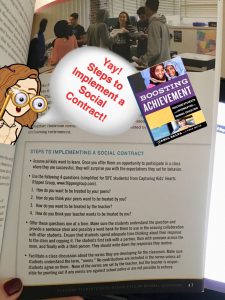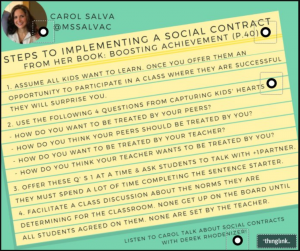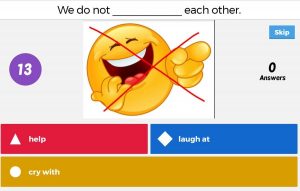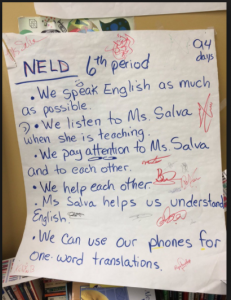Ready for a fresh start? Whether you have great classroom management, or you’re struggling with it, this show should offer you a lot of value! The focus is on two things that have been KEY for me as a teacher of English Learners.
You can listen to the show in iTunes or right here:
Listen to “BAP015 Social Contracts and Choral Reading” on Spreaker.
 In the podcast you hear audio from the video I have included below. As promised here are the steps to implementing a social contract from p. 47 of Boosting Achievement
In the podcast you hear audio from the video I have included below. As promised here are the steps to implementing a social contract from p. 47 of Boosting Achievement
- Assume all kids want to learn. Once you offer them an opportunity to learn in a classroom where they were successful, they will surprise you with the high expectations they will set for behavior.
- Use the following four questions adapted from Capturing Kids Hearts training by the Flippen Group.
- How do you want to be treated by your peers?
- How do you think your peers want to be treated by you?
- How do you want to be treated by the teacher?
- How do you think your teacher wants to be treated by you?
- Give those questions one at a time to your students. They should spend a good bit of time collaborating and being specific. I suggest changing partners many times with that first question so they can use native language and really talk about how they want to be treated.
- Ask students to consider what types of behaviors stand in the way of students taking risks. NONE of the norms should come from you. But if no one brings it up, be sure to ask them about laughing at one another or anything you know is an issue for ELLs.
- Nothing goes on the Social Contract until the entire class agrees on it and they all sign it.
- Return to it frequently. Anytime there is an infraction, you should stop and point out who broke the contract and ask if it needs to be altered.
 I was recently honored by Sarah Lalonde with these notes she took from Boosting Achievement and shared on Twitter. Yes! Please share this. More teachers should know about the impact of this practice.
I was recently honored by Sarah Lalonde with these notes she took from Boosting Achievement and shared on Twitter. Yes! Please share this. More teachers should know about the impact of this practice.
IT IS POWERFUL.
But don’t take my word for it. My students have continually said that the social contract has been one of the biggest factors in their success. My ESL students will also tell you that choral reading was important to them. Reading in unison may or may not fit into your classroom style but if you have ELLs I would strongly suggest that you at least read your key vocabulary out loud with all of your students. For more on that, you can watch the video below. It has teacher and student reflections on choral reading and social contracts.
The video includes a few seconds of Ginny Looney reading her objective with her 6th grade math class. And then there are a few words from some 8th graders in a low socioeconomic area of my district who are talking about why it is important for them. (These are students from Joseph Maurer’s class – a class which scores very high on standardized assessments despite being in a low income area and with many ELLs). At the end of the video you hear from Ginny. She was a teacher who was struggling in her first semester but her 2nd semester was completely different because of those two things. The Social Contract and reading objectives and other things in her classroom in unison (chorally). It’s obvious that Ginny is inspiring her students to collaborate more and giving them ways to do it in a safe environment.
There is no better time to radically improve your classroom climate than after a break. Why not try these things? If you listen to the show I go into detail about how I present them to the students. That is key.
 Reach out with any questions or if you’d like me to come work with you and your teachers! I’d love it. I’d also love to connect with you on Twitter or Facebook.
Reach out with any questions or if you’d like me to come work with you and your teachers! I’d love it. I’d also love to connect with you on Twitter or Facebook.
Stay awesome!
Carol
Also… check out UPCOMING EVENTS to connect in real life!


Hello! I am really interested in trying the social contract and encouraging my staff to do the same in our Advisory classes. I have one major concern though: how do you manage the disruptive/behavioral kids during this activity while also letting them be apart of it? Last year I started to try this and it ended quickly because my kids were not taking it seriously. I just want some advice before I begin this activity with them again!
Hello, Ashley! What a great question. Here are things to consider:
1) Timing. I bet you already know this but it is ALWAYS easier if we do it at the beginning of the year before students are set into negative habits. It is MUCH harder to turn the ship than to keep a ship moving in the right direction. If you are trying to reboot classroom norms later on, it is not impossible, though. Just realize it is much more challenging at this time and plan to do this in August with significant time devoted to it then. So if you’re trying to “start over,” I suggest doing it after a break. Even a 3-day break might help the class feel like it is a natural time to start anew.
2) Ask your staff for their best ideas to handle a small group or 1 student who is working to derail a process. This contract is about capitalizing on what the whole group will agree to. We need to include this child while also getting peer-pressure in our favor. Your staff likely has ideas on how to work with this child/children that are actively being defiant.
Personally, I would:
– Initially ignore rude/disrespectful comments so as to not give attention or reinforce the behavior. I would have a discussion with this child separately from the rest of the class. I would try to build a relationship with them as strongly as possible. There is some reason they are acting out.
– Find a way for this child to have a position of importance. They may respect the process more.
– Next, I would be honest with the class about what we are able to do as a group when the right norms are in place. Maybe look for connections that are relevant to their lives.
Some teachers will tell you that this time of year is just not worth trying something like this. And I agree that it has a MUCH better chance at success when it is implemented at the beginning of the year.
But if you have teachers who need classroom management support, I would brainstorm this question with the whole staff and give it a try!
Ashley,
I also wanted to offer you this “Twitter Moment” that took place Dec 2018. We had a Twitter chat on “Rebooting Classroom Management” that December. There are so many comments about it and some may be useful. https://twitter.com/i/events/1078464877751078912?s=20
Hello! Thank you for sharing this. Do you give students the questions in their native languages?
Hi Amy! This is such an excellent question because my goal is to build their English as quickly as possible. (In the newcomer ESL class) So one might think we need to stay in English. But this task is different. The goal of creating a Social Contract is to create an agreement that everyone buys into. THEY are creating the norms together (with me) and for that, we need then to have AS MUCH comprehension and ability to communicate with each other as possible. So for my class, I give the first question in English on the board [How do you want to be treated?] with comprehensible input. So I act things out, I gesture, I speak slowly, I point… see who is getting it. But after that, I will use google translate with them to be sure they understand the question. Also allowing them to speak in their L1 to communicate, use a translator with each other… WHATEVER they need to understand and respond to that question with each other and with me. I have had to lead kids a bit when I’m getting nothing. Like show the word respect and ask for examples of that. And then ask them if that is what they want. That first question can take the entire class period. So can questions 2, 3 & 4. *** A big caveat to all of this is that I have English speaking and writing goals that we hit every day. (Choral reading, copying, sentence stems, etc) So I make sure we are moving English even though we are using native langauge. Sorry for the long-winded response!
Amazing to read it
harika bir sayfa olmuş, ben türkiye de yaşıyorum. elinize sağlık.